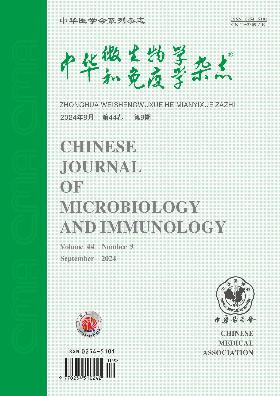龙岩市鼠伤寒沙门氏菌的分子分型、毒力基因及耐药性
Q4 Immunology and Microbiology
引用次数: 0
摘要
目的通过脉冲场凝胶电泳(PFGE)技术分析龙岩市鼠伤寒沙门氏菌的分子分型特征、耐药性和毒力基因,为预防和控制提供参考。方法从2010年至2017年的散发性腹泻和食物中毒病例以及生禽肉样本中分离出79株鼠伤寒沙门氏菌。PFGE测定了15种常用药物对它们的最小抑制浓度(MIC)。用PCR方法检测了55株菌株的9个毒力基因(sopB、invA、sifA、sscA、sseE、spvB、pefA、spvR、spvC)。结果79株鼠伤寒沙门氏菌属于61个PFGE型。P1、P3和P21型菌株分别为10株、3株和4株。从一起食物中毒事件中分离出7株P1型菌株。根据85%的分类标准,79株鼠伤寒沙门氏菌可分为5个优势基因簇(G1-G5)。药敏试验显示,79株菌株对氨苄青霉素的耐药率最高(88.61%),其次是四环素(87.34%)和链霉素(73.41%),对3种或3种以上抗菌药物耐药的多药耐药菌占84.81%(67/79)。55株菌株均携带invA、sopB、sseE和sscA基因。另外5个基因,即sifA、spvC、spvB、spvR和pefA,分别在54、31中检测到。分别为10株、11株和12株。76.4%(42/55)的菌株携带5或6个毒力基因,invA、sopB、sseE、sscA和sifA均呈阳性,spvB、spvR和pefA均为阴性。携带全部9个毒力基因的菌株占18.2%(10/55)。结论龙岩市分离的鼠伤寒沙门氏菌PFGE类型多样。P1、P3和P21型是PFGE的三种主要类型。在食物中毒事件中,PFGE分子分型可以快速预警鼠伤寒沙门氏菌的爆发和可追溯性。应注意鼠伤寒沙门氏菌的多药耐药性。应加强对耐多药菌株的监测和抗菌药物使用的监督。鼠伤寒沙门氏菌携带多种毒力基因,具有较高的毒力。关键词:鼠伤寒沙门氏菌;PFGE分子分型;聚类分析;最小抑制浓度;多药耐药性;毒力基因;沙门氏菌毒力岛;沙门氏菌质粒毒力基因本文章由计算机程序翻译,如有差异,请以英文原文为准。
Molecular typing, virulence genes and drug resistance of Salmonella typhimurium in Longyan city
Objective
To analyze the molecular typing characteristics by pulsed field gel electrophoresis (PFGE), drug resistance and virulence genes of Salmonella typhimurium in Longyan city in order to provide reference for the prevention and control.
Methods
A total of 79 Salmonella typhimurium strains were isolated from sporadic cases of diarrhea and food poisoning and raw poultry meat samples during 2010 to 2017. PFGE was performed to measure the minimum inhibitory concentrations (MIC) of 15 commonly used drugs against them. PCR was used to detect nine virulence genes (sopB, invA, sifA, sscA, sseE, spvB, pefA, spvR, spvC) in 55 strains.
Results
The 79 Salmonella typhimurium strains belonged to 61 PFGE types. There were 10, three and four strains of P1, P3 and P21 types, respectively. Seven P1 type strains were isolate from one food poisoning event. According to the 85% classification standard, 79 Salmonella typhimurium strains could be divided into five predominant gene clusters (G1-G5). Drug susceptibility test showed that the 79 strains had the highest resistance rate to ampicillin (88.61%), followed by that to tetracycline (87.34%) and streptomycin (73.41%). Multidrug resistant bacteria resistant to three or more antibacterial drugs accounted for 84.81% (67/79). All of the 55 strains carried invA, sopB, sseE and sscA genes. The other five genes, sifA, spvC, spvB, spvR and pefA, were detected in 54, 31. 10, 11 and 12 strains, respectively. There were 76.4% (42/55) of the strains carrying five or six virulence genes and all were positive for invA, sopB, sseE, sscA and sifA, and negative for spvB, spvR and pefA. The strains carrying all of the nine virulence genes accounted for 18.2% (10/55).
Conclusions
Salmonella typhimurium strains isolated in Longyan city had a diverse PFGE type. P1, P3 and P21 types were the three predominant PFGE types. In the food poisoning event, PFGE molecular typing could quickly alert the outbreak and traceability of Salmonella typhimurium. Attention should be paid to the multidrug resistance in Salmonella typhimurium. Monitoring of multidrug-resistant strains and supervision on antibacterial drug usage should be strengthened. Salmonella typhimurium had high virulence as it carried many virulence genes.
Key words:
Salmonella typhimurium; PFGE molecular typing; Cluster analysis; Minimum inhibitory concentration; Multidrug resistance; Virulence gene; Salmonella virulence island; Salmonella plasmid virulence gene
求助全文
通过发布文献求助,成功后即可免费获取论文全文。
去求助
来源期刊

中华微生物学和免疫学杂志
Immunology and Microbiology-Virology
CiteScore
0.50
自引率
0.00%
发文量
6906
期刊介绍:
Chinese Journal of Microbiology and Immunology established in 1981. It is one of the series of journal sponsored by Chinese Medical Association. The aim of this journal is to spread and exchange the scientific achievements and practical experience in order to promote the development of medical microbiology and immunology. Its main contents comprise academic thesis, brief reports, reviews, summaries, news of meetings, book reviews and trends of home and abroad in this field. The distinguishing feature of the journal is to give the priority to the reports on the research of basic theory, and take account of the reports on clinical and practical skills.
 求助内容:
求助内容: 应助结果提醒方式:
应助结果提醒方式:


